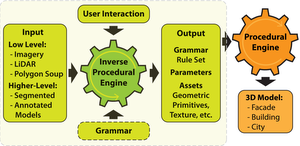Information
- Publication Type: Conference Paper
- Workgroup(s)/Project(s):
- Date: May 2013
- ISBN: 978-3-905674-46-0
- Publisher: Eurographics Association
- Location: Girona, Spain
- Lecturer: Przemyslaw Musialski
- ISSN: 2307-8251
- Editor: V. Tourre and G. Besuievsky
- Booktitle: Proceedings of Eurographics Workshop on Urban Data Modelling and Visualisation (UDMV 2013)
- Conference date: 5. May 2013
- Pages: 31 – 32
- Keywords: inverse procedural modeling, urban modeling, urban reconstruction
Abstract
Procedural modeling is an elegant and fast way to generate huge complex and realistically looking urban sites. Due to its generative nature it can also be referred to as forward-procedural modeling. Its major drawback is the usually quite complicated way of control. To overcome this difficulty a novel modeling paradigm has been introduced: it is commonly referred to as inverse procedural modeling, and its goal is to generate compact procedural descriptions of existing models---in the best case in an automatic manner as possible. These compact procedural representations can be used as a source for the synthesis of identical or similar objects, applied in various simulations and other studies of urban environments. We believe that this technology is still a widely unexplored ground and that it will prove itself as a very important tool in the reconstruction process. In this paper we sketch how inverse procedural modeling can be applied in the urban modeling field.Additional Files and Images
Weblinks
No further information available.BibTeX
@inproceedings{Musialski-2013-ipmum,
title = "Inverse-Procedural Methods for Urban Models",
author = "Przemyslaw Musialski and Michael Wimmer",
year = "2013",
abstract = "Procedural modeling is an elegant and fast way to generate
huge complex and realistically looking urban sites. Due to
its generative nature it can also be referred to as
forward-procedural modeling. Its major drawback is the
usually quite complicated way of control. To overcome this
difficulty a novel modeling paradigm has been introduced: it
is commonly referred to as inverse procedural modeling, and
its goal is to generate compact procedural descriptions of
existing models---in the best case in an automatic manner as
possible. These compact procedural representations can be
used as a source for the synthesis of identical or similar
objects, applied in various simulations and other studies of
urban environments. We believe that this technology is still
a widely unexplored ground and that it will prove itself as
a very important tool in the reconstruction process. In this
paper we sketch how inverse procedural modeling can be
applied in the urban modeling field.",
month = may,
isbn = "978-3-905674-46-0",
publisher = "Eurographics Association",
location = "Girona, Spain",
issn = "2307-8251",
editor = "V. Tourre and G. Besuievsky",
booktitle = "Proceedings of Eurographics Workshop on Urban Data Modelling
and Visualisation (UDMV 2013)",
pages = "31--32",
keywords = "inverse procedural modeling, urban modeling, urban
reconstruction",
URL = "https://www.cg.tuwien.ac.at/research/publications/2013/Musialski-2013-ipmum/",
}


 paper-draft
paper-draft
